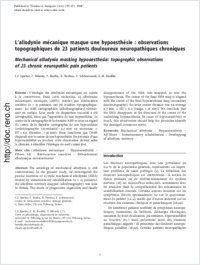Mechanical allodynia masking hypoaesthesia: topographic observations of 23 chronic neuropathic pain patients
- Spicher, Claude J. Centre de rééducation sensitive, clinique générale, Fribourg, Suisse - Unité de physiologie, département de médecine, université de Fribourg, Suisse
- Mathis, F. Centre de rééducation sensitive, clinique générale, Fribourg, Suisse
- Desfoux, N. Centre de rééducation sensitive, clinique générale, Fribourg, Suisse
- Schönenweid, F. Centre de rééducation sensitive, clinique générale, Fribourg, Suisse
- Rouiller, Eric M. Unité de physiologie, département de médecine, université de Fribourg, Suisse
- Ribordy, Farfalla Unité de physiologie, département de médecine, université de Fribourg, Suisse
-
13.11.2008
Published in:
- Douleur et Analgésie. - 2008, vol. 21, no. 4, p. 239-251
Allodynie mécanique
Hypersensibilité
Fibres Aß
Rééducation sensitive
Débordement allodynique extraterritorial
Mechanical allodynia
Hypersensitivity
Aß fibers
Somatosensory rehabilitation
Overlapping of allodynic territory
English
French
The aetiology of mechanical allodynia is still controversial. In the present study, we investigated the precise locations of 25 static mechanical allodynias (SMA) treated by somatosensory rehabilitation (n = 23 patients): the allodynic territory mapped (allodynography) was seen to shrink. The mode of progressive regression and finally disappearance of the SMA was mapped, as was the hypoaesthesia. The center of the final SMA map is aligned with the center of the final hypoaesthesia map (secondary aesthesiography): the inter-center distance was on average 9.7 mm ± SD = 8.0 (range: 1–38 mm). We conclude that the SMA disappears in the direction of the centre of the underlying hypoaesthesia. In cases of hypersensitivity to touch, this observation should help the physician identify the damaged cutaneous nerve.
L’étiologie des allodynies mécaniques est sujette à la controverse. Dans cette recherche, 25 allodynies mécaniques stastiques (AMS), traitées par rééducation sensitive (n = 23 patients), ont été étudiées topographiquement: les AMS cartographiées (allodynographies) rétrécissent en surface. Leur mode de disparition successif a été cartographié, ainsi que l’apparition de leur hypoesthésie. Le centre de la cartographie de la dernière AMS se situe en regard du centre de la dernière cartographie de son hypoesthésie (esthésiographie secondaire): 9,7 mm en moyenne ± ET = 8,0 (étendue: 1–38 mm). Nous concluons que l’AMS disparaît vers le centre de son hypoesthésie. En présence d’une hypersensibilité au toucher, cette observation devrait aider le clinicien à identifier l’étiologie du nerf cutané lésé.
- Faculty
- Faculté des sciences et de médecine
- Department
- Département de Médecine
- Language
-
- French
- Classification
- Medicine
- License
- License undefined
- Identifiers
-
- RERO DOC 11327
- DOI 10.1007/s11724-008-0111-6
- Persistent URL
- https://folia.unifr.ch/unifr/documents/300954
Statistics
Document views: 215
File downloads:
- rouiller_amm.pdf: 313
